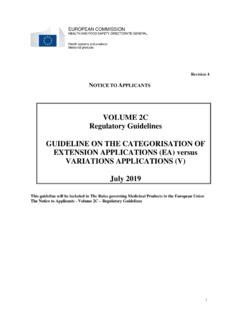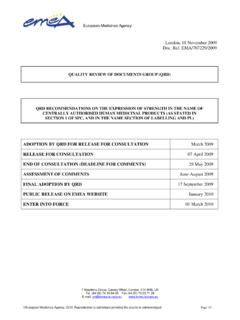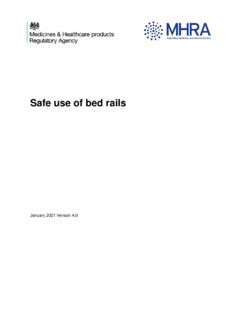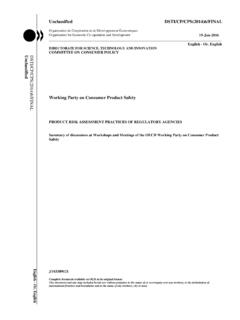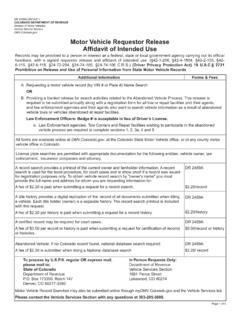Transcription of E2C (R2) Step 5 Periodic benefit-risk evaluation report ...
1 January 2013 EMA/CHMP/ICH/544553/1998 ICH guideline E2C (R2) on Periodic benefit-risk evaluation report (PBRER) Step 5 Transmission to CHMP April 2012 Adoption by CHMP for release for consultation April 2012 End of consultation (deadline for comments) May 2012 Final adoption by CHMP December 2012 Date for coming into effect January 2013 7 Westferry Circus Canary Wharf London E14 4HB United Kingdom An agency of the European Union Telephone +44 (0)20 7418 8400 Facsimile +44 (0)20 7418 8416 E-mail Website European Medicines Agency, 2013. Reproduction is authorised provided the source is acknowledged. EC2 (R2) Periodic benefit-risk evaluation report (PBRER) Table of contents 1. Introduction .. 4 Background .. 4 Objectives .. 5 Scope of the PBRER .. 6 Relation of the PBRER to other ICH documents .. 7 2. General principles .. 7 Single PBRER for an active substance .. 7 PBRERs for fixed dose combination product .. 8 Products manufactured and/or marketed by more than one company.
2 8 Reference information .. 8 Level of detail within PBRER .. 9 Efficacy/Effectiveness .. 9 benefit-risk evaluation .. 10 Periodicity and PBRER data lock point .. 10 International birth date and data lock point .. 10 Managing different frequencies of PBRER submission .. 10 Time interval between data lock point and the submission .. 13 Format and presentation of PBRER .. 13 Format .. 13 Presentation .. 13 3. Guidance on contents of the PBRER .. 14 15 Worldwide marketing approval status .. 15 Actions taken in the reporting interval for safety reasons .. 16 Changes to reference safety information .. 17 Estimated exposure and use patterns .. 17 Cumulative subject exposure in clinical trials .. 17 Cumulative and interval patient exposure from marketing experience .. 18 Data in summary tabulations .. 19 Reference information .. 19 Cumulative summary tabulations of serious adverse events from clinical trials.
3 19 Cumulative and interval summary tabulations from post-marketing data sources .. 20 Summaries of significant safety findings from clinical trials during the reporting interval .. 20 Completed clinical trials .. 21 Ongoing clinical trials .. 21 Long-term follow-up .. 21 Other therapeutic use of medicinal product .. 21 New safety data related to fixed combination terapies .. 22 Findings from non-interventional studies .. 22 ICH guideline E2C (R2) on Periodic benefit-risk evaluation report (PBRER) EMA/CHMP/ICH/544553/1998 Page 2/45 Information from other clinical trials and sources .. 22 Other clinical trials .. 22 Medication errors .. 22 Non-clinical data .. 23 Literature .. 23 Other Periodic reports .. 23 Lack of efficacy in controlled clinical trials .. 23 Late-breaking 23 Overview of signals: new, ongoing, or closed .. 24 Signal and risk evaluation .. 25 Summary of safety concerns .. 25 Signal evaluation .
4 26 evaluation of risks and new information .. 27 Characterisation of risks .. 28 Effectiveness of risk minimisation (if applicable) .. 29 Benefit evaluation .. 29 Important baseline efficacy/effectiveness information .. 29 Newly identified information on efficacy/effectiveness .. 30 Characterisation of benefits .. 30 Integrated benefit-risk analysis for approved indications .. 31 benefit-risk context - medical need and important alternatives .. 31 benefit-risk analysis evaluation .. 31 Conclusions and actions .. 32 Appendices to the PBRER .. 32 4. Appendices to this guideline .. 32 Appendix A .. 34 Appendix B .. 37 Appendix C .. 40 Appendix D .. 42 Appendix E .. 44 Appendix F .. 45 ICH guideline E2C (R2) on Periodic benefit-risk evaluation report (PBRER) EMA/CHMP/ICH/544553/1998 Page 3/45 1. Introduction The Periodic benefit-risk evaluation report (PBRER) described in this guideline is intended to be a common standard for Periodic benefit -risk evaluation reporting on marketed products (including approved drugs that are under further study) among the ICH regions.
5 This guideline defines the recommended format and content of a PBRER and provides an outline of points to be considered in its preparation and submission. Definitions of many technical terms used in the guideline are included in a glossary (Appendix A); the first mention of a term in the guideline is identified with an asterisk (*). Background When a new medicinal product is approved for marketing, demonstration of safety and efficacy are generally based on data from a limited number of patients, many studied under the controlled conditions of randomised trials. Often, higher risk subgroups and patients with concomitant illnesses that require use of other drugs are excluded from clinical trials, and long-term treatment data are limited. Moreover, patients in trials are closely monitored for evidence of adverse events. In clinical practice, monitoring is less intensive, a broader range of patients are treated (age, co-morbidities, drugs, genetic abnormalities), and events too rare to occur in clinical trials may be observed ( , severe liver injury).
6 These factors underlie the need for continuing analysis of relevant safety, efficacy,1 and effectiveness1 information throughout the lifecycle of a medicinal product promptly, as important findings occur and periodically to allow an overall assessment of the accumulating data. Although the majority of new information will be safety-related, new information about effectiveness, limitations of use, alternative treatments, and many other aspects of the drug s place in therapy may be pertinent to its benefit-risk assessment. The ICH Guideline E2C, Clinical Safety Data Management: Periodic Safety Update Reports for Marketed Drugs, achieved Step 4 in 1996, and was intended to harmonise the Periodic reporting requirements to regulatory authorities and to provide, in a common format, the worldwide interval safety experience of a medicinal product at defined times post-approval. At that time, the focus of the Periodic Safety Update report (PSUR) was on relevant new safety information in the context of patient exposure, to determine if changes were needed to the reference safety information* (RSI) in order to optimise the continued safe use of the product .
7 The guideline was revised in 2003, to provide needed clarification, guidance and flexibility. Since that time, the pharmacovigilance environment has evolved, prompting reassessment of the role of the PSUR in the spectrum of safety documents submitted to regulatory authorities. This reassessment highlighted several factors that led to consensus for revision and refocus of the guideline, to enhance its usefulness in light of advances in the field: Significant progress in the technology and science of pharmacovigilance, including electronic submission of individual case safety reports (ICSRs) to regulatory authorities, automated data mining techniques, and more attention to benefit-risk evaluation ; Greater emphasis on proactive and documented risk management planning; Increasing recognition that meaningful evaluation of important new risk information should be undertaken in the context of a medicinal product s benefits ; and Overlap in the content of ICH Guidelines related to pharmacovigilance documentation.
8 1 The terms efficacy and effectiveness are not standardised, and have different meanings across some regions. See Section ICH guideline E2C (R2) on Periodic benefit-risk evaluation report (PBRER) EMA/CHMP/ICH/544553/1998 Page 4/45 As noted above, the primary objective of the PSUR was to provide a comprehensive picture of the safety of approved medicinal products. With recognition that the assessment of the risk of a medicinal product is most meaningful when considered in light of its benefits , the proposed report would provide greater emphasis on benefit than the PSUR, particularly when risk estimates change importantly. In such cases there will need to be an overall explicit evaluation of benefit-risk . Consequently the name of the proposed report is the Periodic benefit-risk evaluation report (PBRER). The PBRER would also provide greater emphasis on the cumulative knowledge regarding a medicinal product , while retaining a focus on new information.
9 A formal evaluation of benefit is a new feature of the PBRER; however, it is recognised that a concise discussion of benefit will usually be sufficient, unless the safety or benefit-risk profile has changed significantly during the reporting interval. Thus, the level of detail provided in certain sections of the PBRER ( , evaluation of safety and efficacy data, evaluation of safety signals,* and benefit-risk evaluation ) should be proportional to the medicinal product s known or emerging important risks and to evidence of emerging important benefits . As the scope of the PBRER has been extended to include benefit as well as safety, the reference information for the report also needs to take this new factor into account. It is generally impractical for marketing authorisation holders (MAHs) to have one reference information source that: encompasses all parameters that contribute towards the benefit-risk evaluation , ( , benefit, efficacy/effectiveness, indication(s) and safety information); is common to all ICH regions; and addresses all circumstances, ( , generics, products licensed in one country only).
10 Therefore, this guideline proposes more practical options that MAHs can consider in selecting the most appropriate reference product information for the PBRER. These proposals incorporate the original ICH E2C concept of reference safety information ( , Company Core Safety Information* [CCSI]), with the addition of the approved indications for the product . This reference product information may be the Company Core Data Sheet* (CCDS) or another document proposed by the MAH (see Section ). The important baseline efficacy and effectiveness information summarised in section of the PBRER will form the basis (or reference ) for the benefit evaluation , irrespective of the reference product information used by the MAH. The frequency of submission of reports to regulatory authorities is subject to national or regional regulatory requirements, and may differ, depending on a number of factors. The guideline includes advice on managing different frequencies of PBRER submission in different regions.










